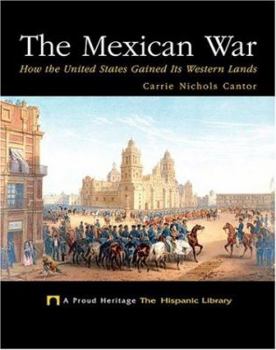The Mexican War: How the United States Gained Its Western Lands
Select Format
Select Condition 
Book Overview
Introduces the Mexican War, also called the Mexican-American War, its causes, course of events, and aftermath. This description may be from another edition of this product.
Format:Library Binding
Language:English
ISBN:1567661769
ISBN13:9781567661767
Release Date:January 2003
Publisher:Child's World
Length:40 Pages
Weight:0.70 lbs.
Dimensions:0.3" x 7.6" x 9.7"
Age Range:8 to 11 years
Grade Range:Grades 3 to 6
Related Subjects
18th Century Children's Children's Books Explore the World History Mexico Military & WarsCustomer Reviews
2 ratings
a los jovenes escolapios.....
Published by Thriftbooks.com User , 19 years ago
este libro enseña a los jovenes pubertos escolapios de la vecina nacion del norte, el como se apoderaron, apañaron, la mitad de nuestro pais, en una guerra de conquista territorila por excelencia, ojala esos pre-adolecentes no se sientan en exceso avergonzados al enterarse de la historia de su pais, al menos de este episodio, del que J.F.K. antes de ser asesinado dijo que era una de las etapas de su historia de la que no podia sentirse muy orgulloso.
The Mexican War as a U.S. war of territorial aquisition
Published by Thriftbooks.com User , 21 years ago
The perspective taken on the Mexican War for this volume in The Hispanic Library is made clear in the book's subtitle: "How the United States Gained Its Western Lands." After winning the American Revolution and the Louisiana Purchase it was the Mexican War that supplied the final significant acquisition of land for the continental United States. Carrie Nichols Cantor makes it clear from the start that from an objective standpoint the Mexican War was a war of aquisition, pointing out that it was the U.S. that started the war. A map shows that from this War the U.S. would get all of Texas, New Mexico, Arizona, Utah, Nevada, and California, as well as the final parts of Wyoming, Colorado, Kansas, and Oklahoma. In telling the story of this 16-month-long war Cantor is concerned with not only what the dramatic acquisition of territory meant for the United States but for Mexico as well.Cantor examines the years before the war to show how the growing number of immigrants was sending thousands of Americans to the west combined with the feeling of manifest destiny to make a conflict with Mexico inevitable. The provocation for the war is detailed in a chapter that shows the American government and military created a pretext for the war. Rather ironically, the weakest chapter in the book is on the actual war itself, which provides a rather bare-boned description of the strategy and battles. The final chapter looks at the way from an ethical perspective, detailing the rights and wrongs on both sides of a war that ended up being quickly forgotten by most Americans. However, the ending of the book is a rather abrupt transition noting peace has reigned on the once disputed border for more than 150 years and the two nations now enjoy a friendly relationship. "The Mexican War: How the United States Gained Its Western Lands" is more a socio-political history than a military history, that goes beyond what students will be getting from their American history textbooks. Cantor takes pains to explain the war so young readers will understand why the United States did things that certainly seem to go against our idea of what the country stands for. Like all volumes produced by The Child's World, this one has informative sidebars (Zachary Taylor, Santa Anna, Los Ninos, etc.), but this time instead of the Interesting Facts beginning worked into the margins they appear at the end of the book, along with a Timeline, Glossary, sources for Further Information, and Index. "The Mexican War" is illustrated with mostly historic photographs and paintings.






